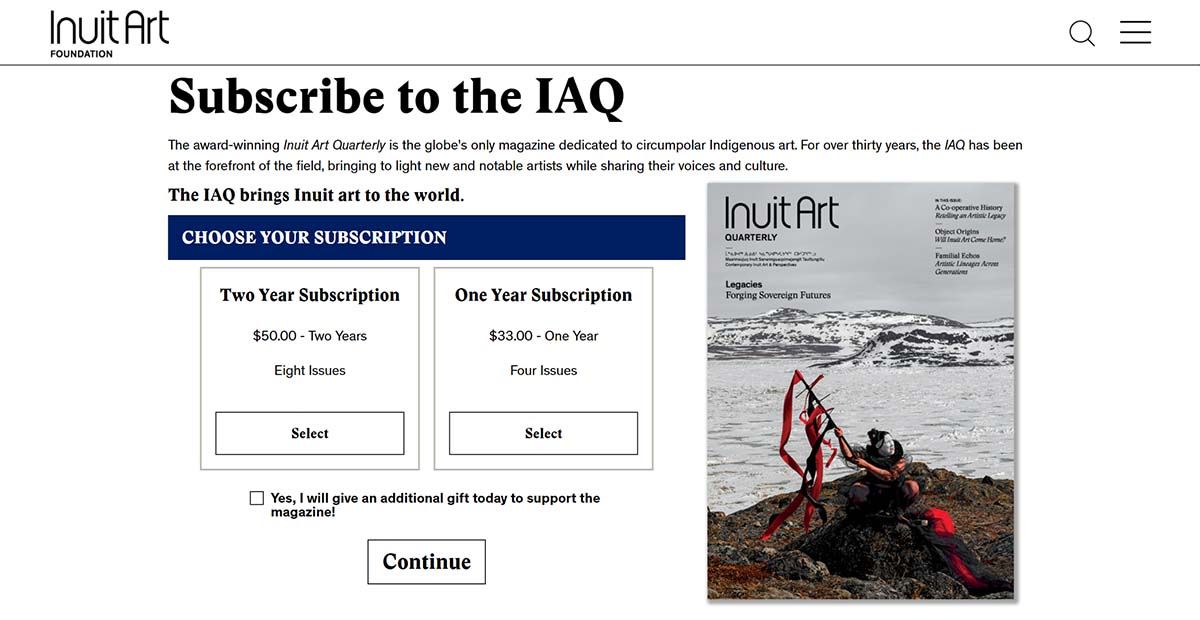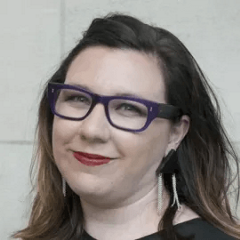Inuit Art Foundation Paints Beautiful Digital Experience with Sitefinity

Inuit Art Foundation’s digital magazine gives artists a platform to show work. Learn more about how they leverage Sitefinity to build eye-catching digital experiences.
If you’ve spent more than five minutes talking to me about digital experiences, I’ve probably mentioned the Inuit Art Foundation.
They bring a voice, a showing, and appreciation to artists across Inuit Nunaat, from what is now Alaska, Canada, Greenland and Eastern Russia—wherever Inuit artists reside and work. That voice is now greatly enhanced with the digital experience offered through the Inuit Art Foundation website powered by the Sitefinity Digital Experience Platform (DXP) from Progress.
Alysa Procida, Inuit Art Foundation Executive Director, spoke with Scott Snowden, a partner at Flywheel Strategic, the digital agency that helped build the site. The conversation was part of the Sitefinity Master Class, ‘Digital Experience to the MAX’.
In this blog, we bring you that conversation where you will learn how the IAF replaced a "Frankensteined" cobbling together of digital tools with a Digital Experience that leverages a cohesive tech stack including Sitefinity, Ucommerce, Salesforce and MailChimp.
Getting to Know the Inuit Art Foundation
Snowden: Alysa, tell us about yourself.
Procida: My name is Alysa Procida, Executive Director of Inuit Art Foundation.  The Inuit Art Foundation is the only national organization mandated to support Inuit artists working in any discipline, anywhere across Canada. Inuit traditional homelands, or Inuit Nunaat, stretches all the way from Eastern Russia to Greenland.
The Inuit Art Foundation is the only national organization mandated to support Inuit artists working in any discipline, anywhere across Canada. Inuit traditional homelands, or Inuit Nunaat, stretches all the way from Eastern Russia to Greenland.
Our digital presence extends beyond traditional borders, but today we are speaking to you from Toronto. This location is on the ancestral and traditional territories of the Mississaugas of the Credit, the Haudenosaunee, the Anishnaabe and the Huron-Wendat, the original owners and custodians of this land. Today, this place is home to many including a diverse urban Indigenous community of Inuit, First Nations and Métis.
We connect Inuit artists with opportunities, which includes residencies, scholarships, funding, and artists’ audiences. We do showcase opportunities, but the thing we're most known for is our magazine, the Inuit Art Quarterly, the only magazine anywhere in the world dedicated to circumpolar Indigenous arts. It is an important vehicle for showcasing Inuit artists to the world. A lot of that is increasingly digital, which is why we work so closely with our digital agency, Flywheel Strategic.
Overcoming Web Frustration
Snowden: What was it like when you took over what was in place. What was your biggest frustration with that system?
Procida: We are a small organization, but we've grown quite a bit in the last five and a half years. Back then, we were restarting the magazine showcasing Inuit art. We inherited a WordPress website that was serviceable, and we could install a bunch of widgets. From that, we “Frankensteined” together a website that kind of worked, kind of didn't, but certainly didn't do all the things that we wanted it to do. We wanted a real platform for our digital publishing, as well as a good experience if you wanted to purchase something from us.
Most importantly, the website barely worked in the North. In the North, where most Inuit artists are working, the internet bandwidth situation is horrendous. The entire territory of Nunavut shares 15 gigabytes of downloads a month.
We were producing content online, because paper's very expensive and a physical magazine doesn't get to everyone we want to reach. Inuit artists themselves often are not able to access physical magazines in their home communities. We decided that we needed to change.
We also decided to take on a whole new publishing wing around what became the IAQ Profiles, which help artists create biographies they are in control of but are publicly accessible. This helps eliminate a big systemic barrier for Inuit artists by giving them agency over that public presentation. We needed to make sure artists always have access to the information published about them.
At the time the Profiles launched, it was conceived as an artist biography database. We put out an RFP for database developers, and that's how we met Flywheel. Flywheel prioritized making sure users in the North had equitable access to the content without sacrificing a beautiful user experience.
Web Building as an Iterative Process
Snowden: We did this in an iterative fashion, and didn't take on the entire website at once. We did a lot of work on the user experience, data structure, and workflows.  That naturally led us to a Sitefinity recommendation. Although it is a customized infrastructure, we were able to leverage the module builder inside Sitefinity to set up that data structure, and very easily enable this whole catalog of information to hold the biographical database. It's an architecture of related objects to hold listings of galleries and exhibitions and other works that are associated.
That naturally led us to a Sitefinity recommendation. Although it is a customized infrastructure, we were able to leverage the module builder inside Sitefinity to set up that data structure, and very easily enable this whole catalog of information to hold the biographical database. It's an architecture of related objects to hold listings of galleries and exhibitions and other works that are associated.
Alysa, you are running Ucommerce to power your e-commerce engine. What did it mean to fully enable that digital experience?
Thriving with E-Commerce
Procida: Our aim, both from a mission and financial sustainability standpoint, which is nice when those two things merge, is to create deeply invested supporters that are interested in what we do across our programs. That often means first subscribing to the IAQ magazine, then becoming a donor when you become more invested in the mission and the artwork.
Now when you go on the website, you can do all those things at one time, as opposed to having to do multiple transactions to buy a subscription and then donate. We all know that's a real way to lose people in that second transaction.
By enabling Ucommerce, we were sure it worked wherever you were on the website. It was seamless, still accessible, but we could also customize what we were doing—and run very specific kinds of campaigns. Specific subscription and fundraising appeals are important to our growth and success. That wouldn't have been possible the previous way that we did e-commerce.
In the first year of setting up Ucommerce, we raised over $100,000 more dollars in donations than we'd had the previous year, which is a lot of money. It has continued to grow, which is great.
Snowden: Now folks can go on your website, subscribe to the magazine, buy a back issue and make a donation—and do that in one cart transaction, one single checkout process?
Procida: You could also become a monthly donor so support artists with recurring revenue, which is even better.
The Artists’ Reception
Snowden: How has this been received by the artists themselves?
Procida: It's been a critical shift for us and the artists we serve. With our digital platform, visitors have gone up over 200% since we switched over to Sitefinity and Ucommerce. It's reaching more people, and it's closer to the beautiful aesthetics of the print magazine.
We worked on the design to make it a consistent experience across the physical and digital environments of the organization. It has been important for artists in terms of growing their careers.
People have gotten gallery representation, so they now have solo sales exhibitions coming out of being on the IAQ Profiles. They now know where their work is collected in the South, and a better sense of their career as an artist. They get more grants, really connect with audiences, and make sales. That's the whole idea. To directly put artists in touch with opportunities that would not have been possible if they didn't have access to it, and if it wasn't compelling to the people visiting the site.
Web Accessibility—Tackling the Bandwidth Challenge
Snowden: Just to add a little bit more color, we've been talking about the accessibility of the information to communities in the far North. To do that, we deploy GEO technology to detect that you are visiting the Inuit Art Foundation’s website from the Arctic, the High North, and remote Canadian communities. It would then switch to a low-bandwidth version.
These days, trying to make a website as lean as possible, and still provide a good user experience, is more challenging than it sounds. We used the multi-lingual capability inside Sitefinity to deploy and to help manage content in parallel, so it can be transmitted, either in a lighter, low-bandwidth format, or in the normal or high bandwidth flavor.
Procida: We also worked with Flywheel to create a more robust and functional customer database in Salesforce that links to Ucommerce. It closes the loop so people can check on the status of their subscription, and we're not spending valuable time entering data manually and making mistakes. It also ensures everyone has a cohesive experience where they feel really valued. We value our community, and the only way that visitors know that is if we demonstrate we know who you are, and we care about you.
Increasing Web Staff Efficiency
Snowden: Has Sitefinity made your staff more effective and efficient?
Procida: Totally. Everyone on our staff has access to the database. If they get an email or call, they can check, "Oh, they've been a subscriber for so long," and say, "Thanks so much for being part of our community for the past seven years," "Thank you for donating recently," or "Thanks for attending our event." It is important to show you care. It is also important to increase efficiency by not having to manually deal with pulling lists for subscriptions, deleting things, and introducing a lot of human error.
Big Digital Dreams
Snowden: What are your plans for the future?
Procida: We have big digital dreams. The most important one is working on dedicated resources for artists, thanks to funding from the Canada Council for the Arts and private supporters. We have focused on the publishing, front-facing parts of what we do. Now we are ramping up the digital presence for our artist services programming.
We are creating a specific portal for artists where they can get assistance and access, peer mentorship opportunities, or other resources around how to get funding, how to negotiate a contract, how to get supplies, write a CV, or get a deeply discounted artist’s subscription to the IAQ.
The next big thing to figure out is making information accessible, relevant, and fully integrated so artists are not getting a sub-par experience compared to the general visitor to the site.
Once again, if you haven’t already caught it, I invite you to watch their engaging dialogue on the Sitefinity Master Class, ‘Digital Experience to the MAX’.

Jennifer McAdams
Jen McAdams was Vice President of Global Demand Generation and Field Marketing.
